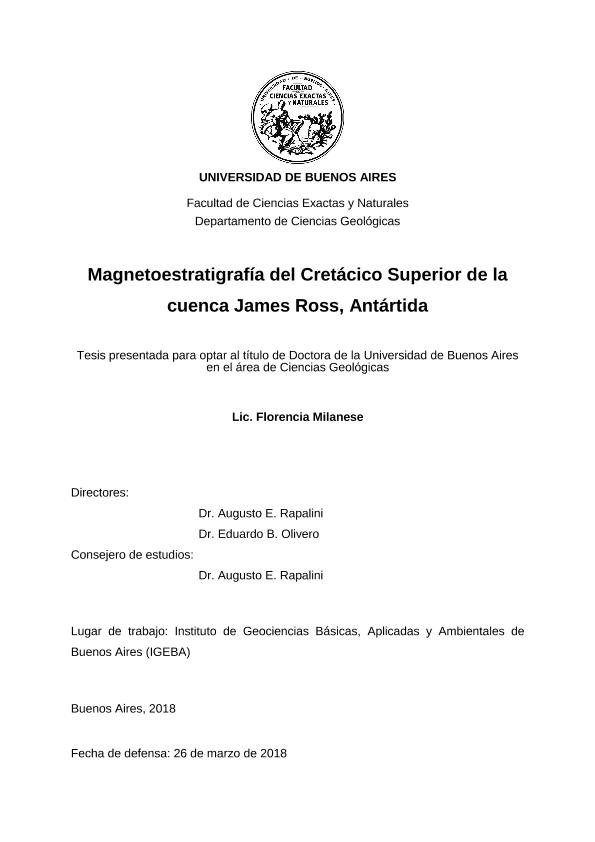Tesis doctoral
Se realizó un estudio magnetoestratigráfico con el objetivo de refinar el marco de edades del Cretácico Superior de la cuenca James Ross, representado por las sedimentitas marinas del Grupo Marambio (Santoniano – Daniano). Hasta el momento, las edades que le han sido asignadas al grupo se basan, casi exclusivamente, en bioestratigrafía de amonites, palinomorfos y nanoplancton calcáreo y en estudios quimioestratigráficos. Si bien previamente se llevaron a cabo trabajos magnetoestratigráficos puntuales en el Grupo Marambio, esta tesis provee un marco cronológico completo, abarcando al grupo en sus facies proximales y distales y desde sus unidades cretácicas más antiguas a más jóvenes. Con un total de 443 direcciones paleomagnéticas obtenidas y más de 3200 m de espesor estratigráfico relevados, se identificaron cinco crones de la escala de tiempo global de polaridades magnéticas: desde los niveles más tardíos del supercron normal cretácico C34N (Santoniano) hasta el cron C31r (Maastrichtiano). A partir de la correlación entre la magnetoestratigrafía y el esquema dado por la bioestratigrafía de amonites, se han podido definir edades precisas para determinados horizontes de las formaciones que conforman el Grupo Marambio. Algunas de las reversiones identificadas son: a) C34N/C33r (84,2 Ma, Santoniano tardío – Campaniano temprano) para un nivel del Miembro Alfa de la Formación Santa Marta; b) C33r/C33n (80 Ma, Campaniano medio) para un nivel intermedio de la Formación Rabot; c) C33/C32 (74 Ma, Campaniano tardío) para un horizonte del Miembro Hamilton Point de la Formación Snow Hill Island; d) C32/C31 (72 Ma, Maastrichtiano temprano) para un nivel basal del Miembro Sanctuary Cliffs de la Formación Snow Hill Island. Adicionalmente, se obtuvieron dos polos paleomagnéticos, de edades aproximadas de 80 y 75 Ma, que coinciden con el polo de referencia para el Cretácico Superior (ca. 90 Ma) de la península Antártica, sugiriendo la ausencia de una rotación oroclinal desde los 90 Ma. Localmente, se identificó la presencia de una posible rotación antihoraria de unos 30° de los depósitos estudiados en la isla Cerro Nevado. A magnetostratigraphic study was carried out on the marine sedimentary rocks of the Marambio Group (Santonian - Danian) in the James Ross Basin, Antarctic Peninsula. The main goal of this thesis is to refine the chronological framework for the Upper Cretaceous, given at present almost exclusively by ammonite, palynomorph, and nanoplankton biostratigraphy and Sr isotopes stratigraphy. Even though there were local previous magnetostratigraphic studies of some sections of the Marambio Group, this thesis provides a complete chronological framework, spanning both proximal to distal facies and from the oldest to the youngest units of the Group. A total of 443 paleomagnetic directions were obtained along more than 3200 m of sedimentary thickness, identifying five polarity chrons from the global polarity time scale. The local magnetostratigraphic column starts in the upper part of the Cretaceous normal superchron C34N (Santonian) and ends at the C31r chron (Maastrichtian). The correlation between the magnetostratigraphy and the age framework given by ammonite biostratigraphy allowed the assignment of precise ages to particular horizons of the Marambio Group units. Some of the geomagnetic polarity reversals identified are: a) C34N/C33r (84,2 Ma, late Santonian – early Campanian) for a horizon in the Alfa Member of the Santa Marta Formation; b) C33r/C33n (80 Ma, middle Campanian) for an intermediate level of the Rabot Formation; c) C33/C32 (74 Ma, late Campanian) for a horizon of the Hamilton Point Member of the Snow Hill Island Formation; d) C32/C31 (72 Ma, early Maastrichtian) for a level at the base of the Sanctuary Cliffs Member of the Snow Hill Island Formation. Additionally, two calculated paleomagnetic poles for approximately 80 and 75 Ma, coincide with the Upper Cretaceous (ca. 90 Ma) reference paleopole for the Antarctic Peninsula. This suggests a lack of oroclinal rotation at least since 90 Ma. Locally, a possible counter-clockwise rotation of the sedimentary sequence studied in the Cerro Nevado (Snow Hill) Island of around 30° was identified
Magnetoestratigrafía del Cretácico Superior de la cuenca James Ross, Antártida
Título:
Magnetostratigraphy of the Upper Cretaceous from the James Ross Basin, Antarctica
Milanese, Florencia Nidia

Director:
Rapalini, Augusto Ernesto

Codirector:
Olivero, Eduardo Bernardo

Fecha de publicación:
26/03/2018
Idioma:
Español
Clasificación temática:
Resumen
Archivos asociados
Licencia
Identificadores
Colecciones
Tesis(IGEBA)
Tesis de INSTITUTO DE GEOCIENCIAS BASICAS, APLICADAS Y AMBIENTALES DE BS. AS
Tesis de INSTITUTO DE GEOCIENCIAS BASICAS, APLICADAS Y AMBIENTALES DE BS. AS
Citación
Milanese, Florencia Nidia; Rapalini, Augusto Ernesto; Olivero, Eduardo Bernardo; Magnetoestratigrafía del Cretácico Superior de la cuenca James Ross, Antártida; 26-3-2018
Compartir



